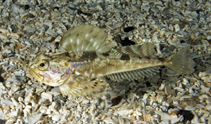| Family: |
Cottidae (Sculpins) |
| Max. size: |
30 cm TL (male/unsexed) |
| Environment: |
demersal; marine; depth range 0 - 556 m |
| Distribution: |
Arctic, Northwest to Northeast Atlantic: to Gulf of St. Lawrence in Canada and rarely Maine, USA. Northeast Atlantic: eastern coasts of Greenland, Iceland, northern coast of Norway to White and throughout Barents Sea to Spitzbergen and Novaya Zemlya (Ref. 4698). |
| Diagnosis: |
Dorsal spines (total): 10-12; Dorsal soft rays (total): 14-17; Anal spines: 0-0; Anal soft rays: 15-19. Back dark, flanks with dark blotches forming two blackish-brown bands, irregular line of dark spots below lateral line; belly light, yellowish in females, with roundish white spots in males; dorsal fin with light and dark stripes, caudal, anal and pectoral fins light, the last with a yellow tip and with 4-5 transverse lines of dark spots (Ref. 4698). |
| Biology: |
Burrows into sand and sand-mud bottoms with salinities of 32-35 ppt, sometimes as low as 16-30 ppt (Ref. 4698). Benthic (Ref. 58426). Feeds on small benthic amphipods and polychaetes (Ref. 4698). |
| IUCN Red List Status: |
Not Evaluated (N.E.) Ref. (130435)
|
| Threat to humans: |
harmless |
Source and more info: www.fishbase.org. For personal, classroom, and other internal use only. Not for publication.

